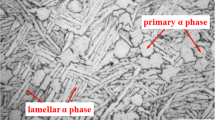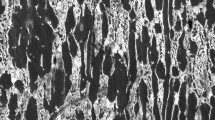Abstract
To seek a fundamental understanding for further improving the Ti-6Al-4 V alloy utilization of cross-wedge rolling (CWR) and the comprehensive mechanical properties of shaft parts, the effect of the CWR processing parameters on the microstructure evolution of Ti-6Al-4 V alloy shaft preform is studied in this paper. An Arrhenius-type microstructure evolution model was employed and implemented into the finite element software DEFORM-3D. The average grain size and dynamic re-crystallization (DRX) volume fraction distribution in the α + β two-phase region and the β single phase region under different rolling temperature, roller rotating speed, and area reduction were analyzed, respectively. It is found that the microstructure evolution of Ti-6Al-4 V alloy is affected by CWR processing parameters. Meanwhile, the corresponding CWR metallographic experiments were conducted to verify the reliability of the FE-simulation results. The difference in average grain size in the β phase region between simulation and experimental is ranged from 5.77 to 18.56%. However, the agreement of the process parameter effect on dynamic recrystallization in the α + β two-phase region is reasonably well. The evenly distributed microstructure can be found as the area reduction rate of 50%, rolling temperature of 950℃ and the speed of 5 r⋅min−1 were employed. In addition, the higher tensile strength of Ti-6Al-4 V alloy shaft preform increased by 18.57% and the plasticity enhanced significantly due to smaller grain size and α + β two-phase microstructure can be obtained by CWR under optimized processing conditions.





















Similar content being viewed by others
Data availability
The manuscript has no associated data or the data will not be deposited.
References
Ji SD, Li ZW, Wang Y, Ma L (2017) Joint formation and mechanical properties of back heating assisted friction stir welded Ti–6Al–4V alloy. Mater Des 113:37–46
Elias CN, Lima JHC, Valiev R, Meyers MA (2008) Biomedical applications of titanium and its alloys. Biological Materials Science 60:46–49
Srinivasu GS, Raja NR (2012) Finite element modeling of stress strain curve and micro stress and micro strain distributions of titanium alloy-a review. J Miner Mater Charact Eng 11:953–960
Fan XG, Yang H, Gao PF (2011) Deformation behavior and microstructure evolution in multistage hot working of TA15 titanium alloy: on the role of recrystallization. J Mater Sci 46:618–628
Chamos AN, Labeas GN, Setsika D (2013) Tensile behavior and formability evaluation of titanium-40 material based on the forming limit diagram approach. J Mater Eng Perform 22:2253–2260
Ezugwu EO, Wang ZM (1997) Titanium alloys and their machinability- a review. J Mater Process Technol 68:262–274
Guo P, Zhao YQ, Zeng WD, Hong Q (2013) The effect of microstructure on the mechanical properties of TC4-DT titanium alloys. Mater Sci Eng A 563:106–111
Li JL, Wang BY, Ji HC, Huang X, Tang XF, Ma WP (2017) Effects of the cross-wedge rolling parameters on the formability of Ti-6Al-4V alloy. Int J Adv Manuf Technol 92:2217–2229
Huo YM, Bai Q, Wang BY, Lin JG, Zhou J (2015) A new application of unified constitutive equations for cross wedge rolling of a high-speed railway axle steel. J Mater Process Technol 223:274–283
Ji HC, Liu JP, Wang BY, Zhang ZR, Zhang T, Hu ZH (2015) Numerical analysis and experiment on cross wedge rolling and forging for engine valves. J Mater Process Technol 221:233–242
Fang G, Lei LP, Zeng P (2002) Three-dimensional rigid-plastic finite element simulation for the two-roll cross-wedge rolling process. J Mater Process Tech 129(1–3):245–249
Wang MH, Xiang D, Xiao C, Zhou J, Jia Z (2012) Influence of cooling condition of tools on central deformation of workpiece and tool wear in cross wedge rolling. Int J Adv Manuf Technol 59(5–8):473–482
Zhou J, Yu YY, Zeng Q (2014) Analysis and experimental studies of internal voids in multi-wedge cross wedge rolling stepped shaft. Int J Adv Manuf Technol 72(9–12):1559–1566
Pater Z (2000) Theoretical and experimental analysis of cross wedge rolling process. Int J Mach Tools Manuf 40(1):49–63
Pater Z, Gontarz A, Weroński W (2006) Cross-wedge rolling by means of one flat wedge and two shaped rolls. J Mater Process Tech 177(1–3):550–554
Pater Z (2010) Development of cross-wedge rolling theory and technology. Steel Res Int 81(9):25–32
Li Q, Lovell MR, Slaughter W, Tagavi K (2002) Investigation of the morphology of internal defects in cross wedge rolling. J Mater Process Tech 125(02):248–257
Li Q, Lovell MR (2004) The establishment of a failure criterion in cross wedge rolling. Int J Adv Manuf Technol 24(24):180–189
Urankar S, Lovell MR, Morrow C, Li Q, Kawada K (2006) Establishment of failure conditions for the cross-wedge rolling of hollow shafts. J Mater Process Tech 177(1–3):545–549
Li Q, Lovell M (2008) Cross wedge rolling failure mechanisms and industrial application. Int J Adv Manuf Technol 37(3–4):265–278
Lee HW, Lee GA, Yoon DJ, Choi S, Na KH, Hwang MY (2008) Optimization of design parameters using a response surface method in a cold cross-wedge rolling. J Mater Process Tech 201(1–3):112–117
Li JL, Wang BY, Ji HC, Huang X, Tang XF, Ma WP (2017) Effects of the cross-wedge rolling parameters on the formability of Ti-6Al-4V alloy. Int J Adv Manuf Technol 92:2217–2229
Li JL, Wang BY, Ji HC, Zhou J, Fu XB, Huang X (2018) Numerical and experimental investigation on the cross-wedge rolling of powder sintering TC4 alloy. Int J Adv Manuf Technol 94:2149–2162
Pater Z, Tomczak J (2012) Experimental tests for cross wedge rolling of forgings made from non-ferrous metal alloys. Achieves of Metallurgy and Materials 57(04):919–928
Pater Z, Bulzak T, Tomczak J (2016) Cross-wedge rolling of driving shaft from titanium alloy Ti6Al4V. Key Eng Mater 687:125–132
Arkadiusz T, Janusz T, Tomasz B (2016) Comparative analysis of forging rolling and cross-wedge rolling of forgings from titanium alloy Ti6Al4V. Key Eng Mater 687:141–148
Li J, Wang B, Qin Y, Fang S, Huang X, Chen P (2019) Investigating the effects of process parameters on the cross wedge rolling of TC6 alloy based on temperature and strain rate sensitivities. Int J Adv Manuf Technol 103(5–8):2563–2577
Ding R, Guo ZX (2004) Microstructural evolution of a Ti–6Al–4V alloy during β-phase processing: experimental and simulative investigations. Mater Sci Eng A 365(1–2):172–179
Li J, Wang B, Fang S, Chen P (2020) Investigation of the microstructure evolution and mechanical properties of a TC6 alloy blade preform produced by cross wedge rolling. Archives of Civil and Mechanical Engineering 20(3)
Wahed MA, Gupta AK, Sharma V, Mahesh K, Kotkunde N (2019) Material characterization, constitutive modelling, and processing map for superplastic deformation region in Ti-6Al-4V alloy. Int J Adv Manuf Technol (3)
Alabort E, Kontis P, Barba D, Dragnevski K, Reed RC (2016) On the mechanisms of superplasticity in Ti–6Al–4V. Acta Mater 105:449–463
Alabort E, Putman D, Reed RC (2015) Super plasticity in Ti–6Al–4V: characterisation, modelling and applications. Acta Mater 95:428–442
Rhaipu S (1998) The effect of microstructural gradients on superplastic forming of Ti–6Al–4V. J Mater Process Technol 80:90–95
Li SK (2017a) Microstructure simulation of TC4 titanium alloy based on DEFORM-3D [D]. Nanchang Aeronautical University
Li J, Wang B, Ji H, Huang X, Tang X, Ma W (2017b) Effects of the cross-wedge rolling parameters on the formability of Ti–6Al–4V alloy. Int J Adv Manuf Technol 92:2217–2229
Whittenberger JD (1986) The influence of grain size and composition on plastic flow in Fe-A1 between1100 and 1400K[J]. Mater Sci Eng 77:103–106
Jha JS, Tewari A, Mishra S, Toppo S (2017) Constitutive relations for Ti-6Al-4V hot working[J]. Procedia Engineering 173:755–762
Funding
We gratefully acknowledge that the project was supported by National Natural Science Foundation of P.R. China (Grant No. 51975301) and by Ningbo Municipal Science and Technology Innovation Major Project (Grant No. 2020Z110). The work was also sponsored by K. C. Wong Magna Fund in Ningbo University.
Author information
Authors and Affiliations
Contributions
The corresponding authors Baoshou Sun and Xing Chen were responsible for determining the suitable structure and contents of this paper. Chen Xing was also responsible for reviewing and editing this paper. Jiayao Yuan was responsible for writing this paper and analyzing all the obtained experimental data. Zhilong Zhao was responsible for all the simulation results. Xuedao Shu was responsible for conceptualization, funding acquisition, and project administration.
Corresponding authors
Ethics declarations
Ethics approval
There is no conflict of interest existing in the submission of this manuscript, and the manuscript is approved by all authors for publication. I would like to declare on behalf of my co-authors that the work described was an original research that has not been published previously, and not under consideration for publication elsewhere, in whole or in part. All the authors listed have approved the manuscript that is enclosed. The results are clear and honest. We have ensured objectivity and transparency in research and ensured that accepted principles of ethical and professional conduct have been followed.
Consent to participate
All the authors listed have approved the enclosed manuscript, and we consent to participate.
Consent to publish
I declare on behalf of my co-authors that we agree with the Copyright Transfer Statement, and we consent to publish.
Competing interests
The authors declare no competing interests.
Additional information
Publisher's Note
Springer Nature remains neutral with regard to jurisdictional claims in published maps and institutional affiliations.
Rights and permissions
About this article
Cite this article
Yuan, J., Chen, X., Zhao, Z. et al. Numerical and experimental study on microstructure evolution of Ti-6Al-4 V alloy shaft preform in cross-wedge rolling process. Int J Adv Manuf Technol 119, 3785–3801 (2022). https://doi.org/10.1007/s00170-021-08440-1
Received:
Accepted:
Published:
Issue Date:
DOI: https://doi.org/10.1007/s00170-021-08440-1




